Research Experience
Postdoctoral Research
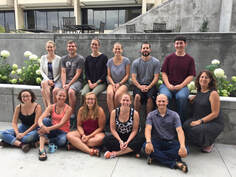 As a postdoc at Virginia Tech, I worked on a number of collaborative
projects related to lake biogeochemistry. In a collaboration between
computer scientists and limnologists through the PRAGMA-GLEON
expedition, I modeled how nitrogen and phosphorus cycling in a
eutrophic lake and oligotrophic lake may respond differently to climate
warming (Farrell
et al. 2020). I also contributed to a multidisciplinary Coupled
Natural Human Systems project- CNH-Lakes (Cobourn
et al. 2018)- where I helped link models of lake water chemistry and
economics to explore how water clarity and phytoplankton blooms affect
properly values near lakes (Weng
et al. 2020).
As a postdoc at Virginia Tech, I worked on a number of collaborative
projects related to lake biogeochemistry. In a collaboration between
computer scientists and limnologists through the PRAGMA-GLEON
expedition, I modeled how nitrogen and phosphorus cycling in a
eutrophic lake and oligotrophic lake may respond differently to climate
warming (Farrell
et al. 2020). I also contributed to a multidisciplinary Coupled
Natural Human Systems project- CNH-Lakes (Cobourn
et al. 2018)- where I helped link models of lake water chemistry and
economics to explore how water clarity and phytoplankton blooms affect
properly values near lakes (Weng
et al. 2020).
In addition, I worked with Cayelan Carey to develop Macrosystems EDDIE- a curriculum of teaching modules that help introduce undergraduate students to macrosystems ecology concepts through the use of simulation modeling and R (Farrell & Carey 2018).
PhD Research
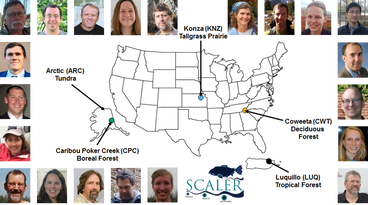 My
PhD research was part of the Scale,
Consumers, And Lotic
Ecosystem Rates (SCALER) project,
which was a collaborative Macrosystems biology project that has included
headwater stream networks in five biomes across North America (tropical
forest, temperate mountainous forest, prairie, northern boreal evergreen
forest, & tundra), with the goal of determining how small-scale
ecological experiments be applied to understand patterns and processes
at the ecosystem scale (Rüegg
et al. 2016;Song et
al. 2018).
My
PhD research was part of the Scale,
Consumers, And Lotic
Ecosystem Rates (SCALER) project,
which was a collaborative Macrosystems biology project that has included
headwater stream networks in five biomes across North America (tropical
forest, temperate mountainous forest, prairie, northern boreal evergreen
forest, & tundra), with the goal of determining how small-scale
ecological experiments be applied to understand patterns and processes
at the ecosystem scale (Rüegg
et al. 2016;Song et
al. 2018).
My research was focused on quantifying linkages between structure and function in headwater stream networks, with field work based out of the Coweeta Hydrologic Lab in Macon County, North Carolina (USA). I was particularly interested in understanding how the removal of large aquatic consumers (salamanders, crayfish, fishes) changed rates of stream metabolism and nutrient uptake, because understanding how organism losses affect stream processes could help predict stream responses to environmental disturbance and biodiversity loss. In addition, I asked questions about how aquatic food webs, in terms of primary and secondary consumers, and the basal resources they feed upon, change along stream networks (Farrell et al. 2018).
GLEON Fellowship
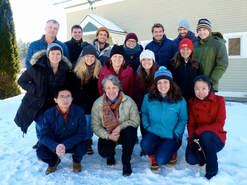 As
a member of the 2nd cohort of the Global Lakes Ecological Observatory
Network (GLEON) Fellowship Program (2015-2017), I gained hands-on
experience in both interdisciplinary team science & macrosystems
biology. Our working groups focused on:
As
a member of the 2nd cohort of the Global Lakes Ecological Observatory
Network (GLEON) Fellowship Program (2015-2017), I gained hands-on
experience in both interdisciplinary team science & macrosystems
biology. Our working groups focused on:
documenting long-term trends in salt concentrations in lakes (Dugan et al. 2017) and
developing simple dynamic models for organic carbon cycling in lakes (McCullough et al. 2018).
Earlier Projects
Crayfish/Branchiobdellid Symbiosis Research
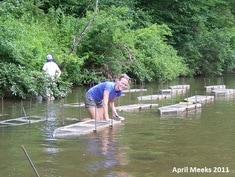 While
pursuing my Master’s degree, I studied aspects of the cleaning symbiosis
between crayfish (Cambarus spp.) and branchiobdellid worms
(Annelida: Branchiobdellidae). My research specifically sought to
determine why two co-existing crayfish (Cambarus chasmodactylus
and Orconectes cristavarius) differ in the number of worms
(Cambarincola ingens) they host.
While
pursuing my Master’s degree, I studied aspects of the cleaning symbiosis
between crayfish (Cambarus spp.) and branchiobdellid worms
(Annelida: Branchiobdellidae). My research specifically sought to
determine why two co-existing crayfish (Cambarus chasmodactylus
and Orconectes cristavarius) differ in the number of worms
(Cambarincola ingens) they host.
Collaborators: Dr. Robert Creed; Dr. Bryan Brown; Dr. James Skelton
Whooping Crane Direct Autumn Release Internship
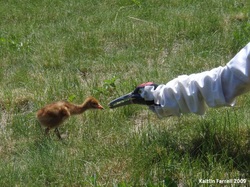 Working
in collaboration with the International Crane Foundation and the US Fish
& Wildlife Service, I spent 6 months (2009) in Baraboo and Necedah,
WI isolation-rearing whooping crane chicks for release.
Working
in collaboration with the International Crane Foundation and the US Fish
& Wildlife Service, I spent 6 months (2009) in Baraboo and Necedah,
WI isolation-rearing whooping crane chicks for release.
Tropical Stream Independent Research
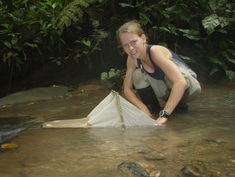 As an
undergraduate, I designed and conducted a 5-month (2008) field study on
macroinvertebrate communities in Ecuadorian tropical forest streams.
Based out of the Estación Biológica Bilsa in northwestern Ecuador, I
examined whether the forest type (primary forest vs. secondary regrowth)
adjacent to perennial streams affected aquatic macroinvertebrate
community structure and diversity.
As an
undergraduate, I designed and conducted a 5-month (2008) field study on
macroinvertebrate communities in Ecuadorian tropical forest streams.
Based out of the Estación Biológica Bilsa in northwestern Ecuador, I
examined whether the forest type (primary forest vs. secondary regrowth)
adjacent to perennial streams affected aquatic macroinvertebrate
community structure and diversity.
Boston University Bat Lab Summer Research Assistant
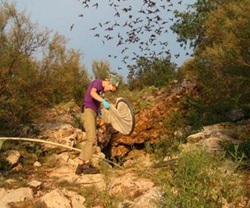 I spent
the summer of 2006 assisting Louise Allen (PhD, Boston U.) with her
dissertation research on Brazilian free-tailed bats (Tadarida
brasiliensis). Research was conducted near Austin, TX through the
BU Bat Lab.
I spent
the summer of 2006 assisting Louise Allen (PhD, Boston U.) with her
dissertation research on Brazilian free-tailed bats (Tadarida
brasiliensis). Research was conducted near Austin, TX through the
BU Bat Lab.